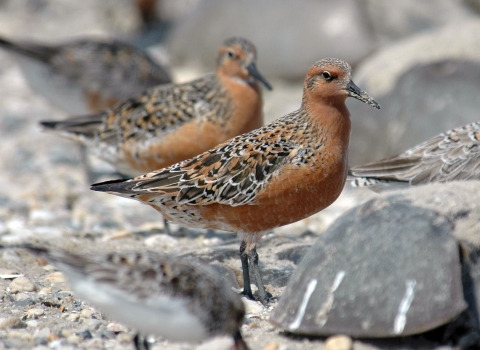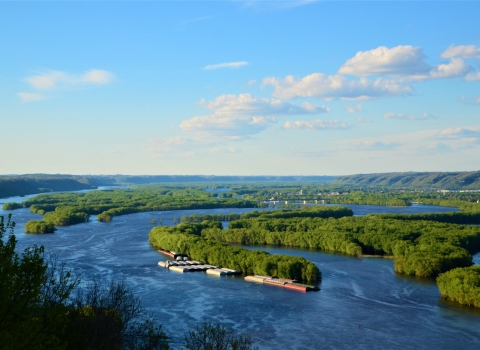The U.S. Fish and Wildlife Service has finalized a recovery plan for the rufa red knot, a subspecies listed as threatened under the Endangered Species Act. The recovery plan, which was made available for public comment in May 2021, provides a road map for helping the bird flourish to the point that it no longer needs federal protection.
The recovery plan is a non-regulatory guidance document that identifies, organizes and prioritizes site-specific recovery actions, sets measurable recovery objectives, and includes time and cost estimates for removing the rufa red knot from the federal list of endangered and threatened species. The Service is also finishing an accompanying Recovery Implementation Strategy that steps down actions from the recovery plan into detailed activities.
The rufa red knot was listed as threatened in 2015 due to population declines linked to multiple threats and stressors that have impacted habitat and food supply across its vast range. One of the longest-distance migrants in the animal kingdom, rufa red knots travel as far as 18,000 miles each year between their breeding grounds on the central Canadian arctic tundra and four wintering regions, ranging from North Carolina to Chile.
The subspecies’ unique and impressive life history depends on suitable habitat, food and weather conditions across a network of far-flung sites that are vulnerable to development, disturbances and complex challenges related to climate change climate change
Climate change includes both global warming driven by human-induced emissions of greenhouse gases and the resulting large-scale shifts in weather patterns. Though there have been previous periods of climatic change, since the mid-20th century humans have had an unprecedented impact on Earth's climate system and caused change on a global scale.
Learn more about climate change . Beaches and marshes continue to be lost to sea-level rise, shoreline stabilization and development. Climate change also affects the availability of food, the timing of annual migrations, and breeding habitat in the Arctic.
Recovery of the rufa red knot can be achieved only through coordinated conservation efforts involving public and private partners who share a commitment to this common goal. The plan reflects input from natural resources agencies and conservation organizations across the species’ range.
Many of these partners are already working to advance rufa red knot recovery in wintering, breeding and migration stopover areas by restoring habitat, reducing disturbances to birds from human activities, and implementing new technology to track migration. Other key actions highlighted in the recovery plan include safeguarding the rufa red knot’s food supplies, filling data gaps, coordinating communication and outreach, and addressing new threats as they emerge.
Actions to benefit the rufa red knot support other species that share their habitats, including piping plovers, loggerhead sea turtles, northeastern beach tiger beetles, seabeach amaranth and aboriginal prickly apples. Intact, coastal habitats are also more resilient to climate change, and can help buffer nearby communities from associated impacts.
The recovery plan is available here: https://ecos.fws.gov/ecp/species/1864#recovery
Communities and countries all over the world are dealing with a crisis of extinction. With climate change and habitat loss pushing more and more species to the brink, now is the time to be proactive, collaborative, and innovative in our efforts to save America's wildlife and plant species.
Today’s announcement comes as the ESA turns 50 years old in 2023. Throughout the year, the Department of the Interior will celebrate the ESA's importance in preventing imperiled species' extinction, promoting the recovery of wildlife and conserving the habitats upon which they depend.
The ESA has been highly effective and credited with saving 99% of listed species from extinction. Thus far, more than 100 species of plants and animals have been delisted based on recovery or reclassified from endangered to threatened based on improved conservation status, and hundreds more species are stable or improving thanks to the collaborative actions of Tribes, federal agencies, state and local governments, conservation organizations and private citizens.




